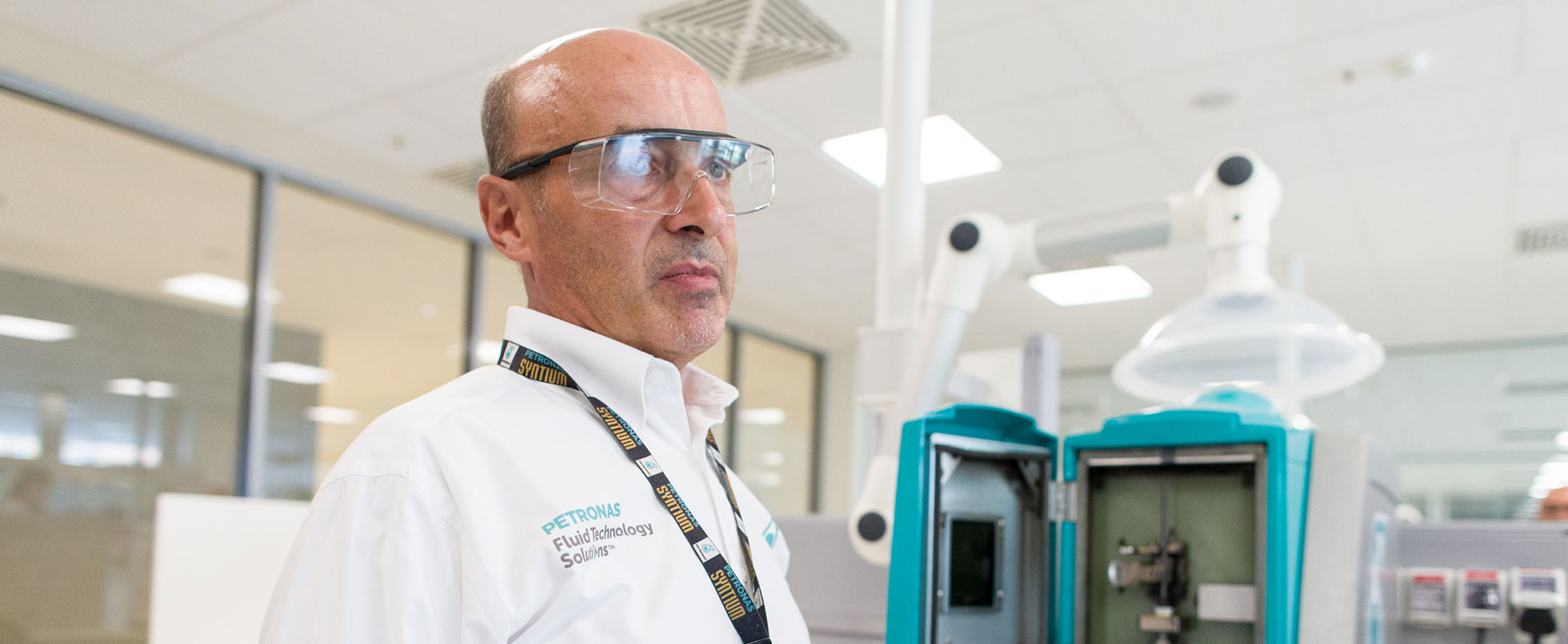
Petronas Lubricants International’s Chief Technology Officer Eric Holthusen talks to Lubes’n’Greases about the launch of a new range of hybrid and electric vehicle lubricants.
Not only is Petronas in pole position as the main sponsor and fluids supplier to the mighty Mercedes AMG Petronas Formula 1 team, it is also competing in the lubricants race with the announcement of a new range of EV fluids and a formulation specifically for hybrids.
PLI Managing Director and Group Chief Executive Officer Giuseppe D’Arrigo and Chief Technology Officer Eric Holthusen launched the two product ranges at the Geneva International Motor Show 2019 under the brand name Petronas iona and Syntium 7000 Hybrid. They were described by the company as part of its pledge to address the climate challenge and lower carbon dioxide emissions through fluid technology.
Petronas iona Thermal is a battery thermal management fluid; Petronas iona is a range of Integra e-transmission fluids and Petronas iona Glide are bearing greases.
The hybrid crankcase fluid carries Petronas’ top-tier Syntium branding, and the company claims it has been formulated to give excellent engine wear and cleanliness, as well as performance to address the loads and stresses on engine components that result from frequent engine restarts.
Holthusen outlined the common challenges faced by developers of hybrid engine oils. “The technology for Petronas Syntium 7000 Hybrid was particularly chosen to address the specific stress that hybrid operation puts on engines and lubricants.” Unlike start-stop systems, where the engine is switched off for brief moments when stopped in traffic, for example, a full hybrid turns the internal combustion engine off for an extended period during battery operation, allowing the lubricant to drain down to the sump and engine temperatures to drop, he told Lubes’n’Greases.
“For those reasons, superior wear protection, sludge prevention and viscosity stability are of vital importance. Syntium Hybrid 7000’s technology is specifically suited to deal with these peculiar hybrid vehicle conditions while at the same time protect the engine and retain the lubricant’s performance throughout the oil drain interval,” Holthusen continued.
Petronas iona Thermal covers the current range of battery types and configurations requiring either water- or non-aqueous-based thermal management fluids. Battery and thermal management configurations are continuously evolving for higher efficiency and longer durability, and Petronas is engaged in research and development work on thermal management fluids in-house and with a university with expertise in battery thermal management.
“Petronas iona Thermal has been used by OEMs as initial fill since some time, and the in-service experience is excellent,” said Holthusen.
Range anxiety, which is associated with the ability of the battery to provide sufficient electrical energy for the demand placed on it, is usually one of the main obstacles to EV ownership – another being relatively high vehicle cost – and the drivetrain fluid’s role is to minimize energy losses due to friction and drag. The Petronas iona Integra range has been formulated to manage friction by ensuring minimal losses in the integrated driveline, thus helping to extend the range of the EV, the company claims.
E-transmission fluids must play another role in integrated e-drivetrains, where the electric motor and gears are housed in the same casing and are immersed in the same fluid for both cooling and lubrication purposes. The integration of components into an electric drive unit means that there is a demand to lubricate the reduction gearbox and thermally manage the electric motor and power electronics.
“Where lubricants are used for direct cooling of electric motors, this places several additional performance demands on the fluid, such as thermal or oxidation stability, electrical and materials compatibility and corrosion inhibition,” Holthusen continued.
To improve the efficiency of the electric motor in the EDU, there is demand to run the motor at higher speeds of up to 20,000 revolutions per minute.
“At these higher speeds, prevention of foaming of the lubricant is a requirement that must be addressed during the fluid development,” he said.
In an EV, the absence of an ICE means that noise from bearings, constant velocity joints and transmission become much more obvious to the driver. Noise can be reduced by the appropriate formulation of lubricants and greases. This is another key property addressed in the development of Petronas iona Integra and Glide products, the company says.
The Petronas iona products have been supplied to original equipment manufacturers and are in already use in EVs and hybrids in the field.
Petronas is in the middle of an industry-wide study into the future trends of EV technology and what this means for EV fluids. The findings of this research will be shared at Petronas’ EV Fluids Technology Symposium, which is scheduled to take place at PLI’s global research and technology center in Turin in the fourth quarter of this year. Holthusen said the symposium would be attended by experts from across the EV industry, including EV assembly OEMs, suppliers and automobile engineering consultants.
“OEMs have approached us and are partnering with us on their e-drivetrains. Nevertheless, we see e-mobility and associated developments as an area of continuous evolution,” said Holthusen.

Sorry, a technical error occurred and we were unable to log you into your account. We have emailed the problem to our team, and they are looking into the matter. You can reach us at lubesngreases@omeda.com.
Click here link to homepage